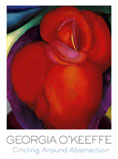
It is easy to fall under the spell of the paintings by Georgia O'Keeffe that we know best: the iconic images of magnified flowers, floating cattle skulls, and arid desert landscapes. Such paintings are even more popular today than when O'Keeffe created them more than half a century ago. But it is important to remember-as striking and innovative as works like these are-that O'Keeffe also produced many other, more radical, paintings that made an equally important contribution to the history of twentieth-century art.
O'Keeffe's exploration of abstraction placed her at the forefront of the American avant-garde. While most retrospective exhibitions of O'Keeffe's art begin, appropriately, with her breakthrough abstract charcoal drawings of 1915, the fact that she continued to paint in this mode throughout her career is almost always overshadowed by the popularity of her more representational canvases. Like many of her peers, she took daring risks as she worked, experimenting adventurously with color, scale, and composition. What truly distinguished O'Keeffe from her contemporaries, however, was her innovative and consistent approach to abstraction: an approach rooted not in esoteric theories and rigid, grid-oriented geometry, but rather in a highly personal interpretation of her subject matter that she consistently realized through a unique vocabulary of circular forms.
Georgia O'Keeffe: Circling Around Abstraction brings together forty-two of the artist's bold abstractions-including charcoals, watercolors, pencil drawings, pastels, oils, and sculpture-that together underscore the originality and clarity of her vision. By isolating this aspect of O'Keeffe's work, this exhibition invites visitors to discover the myriad ways in which she literally and figuratively "circled around abstraction," beginning with the swirling vortices of her early charcoals and continuing through the pulsing volumes of her paintings of the 1920s and 1930s, the infinite voids of her pelvis series of the 1940s, and the new directions that her art took during the final decades of her career.

